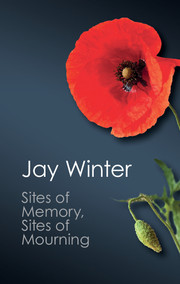Book Review: Sites of Memory, Sites of Mourning, by Jay Winter
 Sites of Memory, Sites of Mourning: The Great War in European Cultural History, Prof Jay Winter - £12.99 (paperback) www.cambridge.org, Cambridge University Press, 1995 (2014).
Sites of Memory, Sites of Mourning: The Great War in European Cultural History, Prof Jay Winter - £12.99 (paperback) www.cambridge.org, Cambridge University Press, 1995 (2014).
⭐⭐⭐⭐⭐ - A must-read seminal study into the themes and influences of Great War cultural commemoration.
'Remembrance is part of the landscape', Jay Winter declares on the first page of this book. And it certainly is, as many of my posts on this blog have shown. Each town and village across the country has its own war memorial, sometimes more than one, as well as religious and individual tributes to those who served and died in the First World War. Winter uses this book to delve into the language and practices used in commemorating and memorialising the war, discussing both those adopted organically and from central leadership, across the principal nations of Europe.I first read some of Winter's work in my second year of university and was instantly fascinated with his study of the culture of memory which developed out of the First World War. He is an undoubted influence on my own work, and I often think to his analysis of 'ritual expression of ... bereavement' when visiting or writing about a memorial or cemetery.
His central argument, that 'the Great War, the most 'modern' of wars, triggered an avalanche of the 'unmodern',' is clear in any investigation of interwar commemoration. Many of these traditions, new in the 1920s, held their origins in Victorian and Edwardian cultures, and a century later, we still observe them today. Remembrance Sunday, the Two-Minute Silence, and the language of Ultimate Sacrifice, are all instances of this "unmodern" memory and a continued stasis of remembrance practices. Borne out of late-nineteenth century religious patriotism, they have become sacred to the identity of remembrance, despite the changing contexts of society.
Historians such as Adrian Gregory have argued that Winter's findings have been overstated, but in my own work, particularly in studying personal faith and community-level commemoration, I have found them to carry great value. The widespread use of Biblical passages and quotations from classical poetry on memorial and gravestone epitaphs, for example, are demonstrations of the deepening tradition of 'older languages of loss and consolation' after 1918, which Winter has argued were an 'immediate repercussion' of the war. Such traditions were a convenient means by which to communicate feelings of grief and to verbalise untold pain. Furthermore, such language could evoke images by collective understanding, such as Winter cites with the literalisation of Hell in presentations of the suffering of the trenches.
Winter's deft analysis of post-Great War culture lucidly weighs up the overlaps and distinctions between the parallel experiences of Britain, France and Germany, through the use of wide-ranging and thorough examples. For instance, in war poetry he traces the key motifs of the Old and New Testaments in discussing war; the 'sacrifice' of Old, and 'parables' of New. This, he argues, was a 'backward gaze', not dissimilar from the tradition of memorials and commemoration. Poetry is, after all, a literary memorial to the era and context in which it was written and its poet lived.
Through his expansive study of the response of culture and art to the First World War, Jay Winter has created a masterful text chronicling and analysing the conflict's impact on European societies. It is a book which will reshape the way you see war memorials and its lessons will stay in your mind for a long time to come. Winter skilfully balances the ethos of art and ritual with the responses of its audience as inseparable sides of one coin. This gives a completeness to the book, and although it extends an already broad scope of study, Winter handles it effectively to present a comprehensive study of the tradition and character of 'Sites of Memory' and 'Sites of Mourning' in the aftermath of the First World War.
Kathryn
PS. I am not affiliated with Jay Winter or Cambridge University Press, and the views expressed above are entirely my own. Quotations all come from 'Sites of Memory, Sites of Mourning'.



No comments: